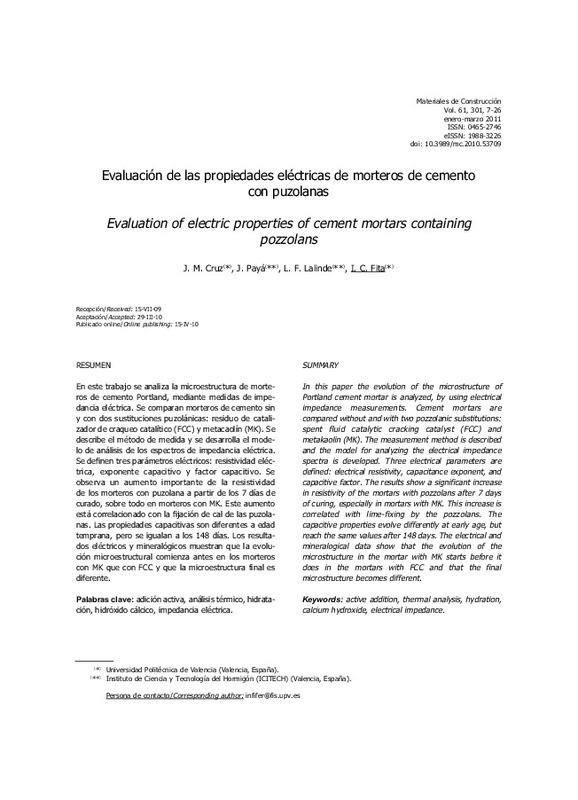JavaScript is disabled for your browser. Some features of this site may not work without it.
Buscar en RiuNet
Listar
Mi cuenta
Estadísticas
Ayuda RiuNet
Admin. UPV
Evaluación de las propiedades eléctricas de morteros de cemento con puzolanas
Mostrar el registro sencillo del ítem
Ficheros en el ítem
| dc.contributor.author | Cruz González, José Mª
|
es_ES |
| dc.contributor.author | Paya Bernabeu, Jorge Juan
|
es_ES |
| dc.contributor.author | Lalinde Castrillón, Luis Felipe
|
es_ES |
| dc.contributor.author | Fita Fernández, Inmaculada Concepción
|
es_ES |
| dc.date.accessioned | 2013-04-29T10:53:29Z | |
| dc.date.available | 2013-04-29T10:53:29Z | |
| dc.date.issued | 2011 | |
| dc.identifier.issn | 0465-2746 | |
| dc.identifier.uri | http://hdl.handle.net/10251/28299 | |
| dc.description.abstract | [ES] En este trabajo se analiza la microestructura de morteros de cemento Portland, mediante medidas de impedancia eléctrica. Se comparan morteros de cemento sin y con dos sustituciones puzolánicas: residuo de catalizador de craqueo catalítico (FCC) y metacaolín (MK). Se describe el método de medida y se desarrolla el modelo de análisis de los espectros de impedancia eléctrica. Se definen tres parámetros eléctricos: resistividad eléctrica, exponente capacitivo y factor capacitivo. Se observa un aumento importante de la resistividad de los morteros con puzolana a partir de los 7 días de curado, sobre todo en morteros con MK. Este aumento está correlacionado con la fijación de cal de las puzolanas. Las propiedades capacitivas son diferentes a edad temprana, pero se igualan a los 148 días. Los resultados eléctricos y mineralógicos muestran que la evolución microestructural comienza antes en los morteros con MK que con FCC y que la microestructura final es diferente. | es_ES |
| dc.description.abstract | [EN] In this paper the evolution of the microstructure of Portland cement mortar is analyzed, by using electrical impedance measurements. Cement mortars are compared without and with two pozzolanic substitutions: spent fluid catalytic cracking catalyst (FCC) and metakaolin (MK). The measurement method is described and the model for analyzing the electrical impedance spectra is developed. Three electrical parameters are defined: electrical resistivity, capacitance exponent, and capacitive factor. The results show a significant increase in resistivity of the mortars with pozzolans after 7 days of curing, especially in mortars with MK. This increase is correlated with lime-fixing by the pozzolans. The capacitive properties evolve differently at early age, but reach the same values after 148 days. The electrical and mineralogical data show that the evolution of the microstructure in the mortar with MK starts before it does in the mortars with FCC and that the final microstructure becomes different. | es_ES |
| dc.description.sponsorship | Authors thank to Ministerio de Educacion (Spanish research plan) the financial support to the projects BIA 2006-15188-C03-02 y BIA 2004-00520, with FEDER co-financing. Also thank to Universidad Politecnica de Valencia (Vicerrectorado de Investigacion) the research grant for L.F. Lalinde (PPI-01-04 ref 5939) and financial support to the project PAID-05-09 ref 4302. | en_EN |
| dc.language | Español | es_ES |
| dc.language | Inglés | en_EN |
| dc.publisher | CSIC | es_ES |
| dc.relation.ispartof | Materiales de Construcción | es_ES |
| dc.rights | Reconocimiento - No comercial (by-nc) | es_ES |
| dc.subject | Adición activa | es_ES |
| dc.subject | Análisis térmico | es_ES |
| dc.subject | Hidratación | es_ES |
| dc.subject | Hidróxido cálcico | es_ES |
| dc.subject | Impedancia eléctrica | es_ES |
| dc.subject | Active addition | es_ES |
| dc.subject | Thermal analysis | es_ES |
| dc.subject | Hydration | es_ES |
| dc.subject | Calcium hydroxide | es_ES |
| dc.subject | Electrical impedance | es_ES |
| dc.subject.classification | FISICA APLICADA | es_ES |
| dc.subject.classification | INGENIERIA DE LA CONSTRUCCION | es_ES |
| dc.title | Evaluación de las propiedades eléctricas de morteros de cemento con puzolanas | es_ES |
| dc.title.alternative | Evaluation of electric properties of cement mortars containing pozzolans | es_ES |
| dc.type | Artículo | es_ES |
| dc.identifier.doi | 10.3989/mc.2010.53709 | |
| dc.relation.projectID | info:eu-repo/grantAgreement/MEC//BIA2006-15188-C03-02/ | es_ES |
| dc.relation.projectID | info:eu-repo/grantAgreement/MEC//BIA2004-00520/ES/DESARROLLO DE NUEVOS MATERIALES COMPUESTOS FABRICADOS CON FIBRAS DE VIDRIO ALCALI-RESISTENTES Y CONGLOMERANTES CON ADICIONES MINERALES ACTIVAS/ | es_ES |
| dc.rights.accessRights | Abierto | es_ES |
| dc.contributor.affiliation | Universitat Politècnica de València. Departamento de Ingeniería de la Construcción y de Proyectos de Ingeniería Civil - Departament d'Enginyeria de la Construcció i de Projectes d'Enginyeria Civil | es_ES |
| dc.contributor.affiliation | Universitat Politècnica de València. Departamento de Física Aplicada - Departament de Física Aplicada | es_ES |
| dc.contributor.affiliation | Universitat Politècnica de València. Instituto de Ciencia y Tecnología del Hormigón - Institut de Ciència i Tecnologia del Formigó | es_ES |
| dc.description.bibliographicCitation | Cruz González, JM.; Paya Bernabeu, JJ.; Lalinde Castrillón, LF.; Fita Fernández, IC. (2011). Evaluación de las propiedades eléctricas de morteros de cemento con puzolanas. Materiales de Construcción. 61(301):7-26. https://doi.org/10.3989/mc.2010.53709 | es_ES |
| dc.description.accrualMethod | S | es_ES |
| dc.relation.publisherversion | http://materconstrucc.revistas.csic.es/index.php/materconstrucc/article/view/216/262 | es_ES |
| dc.description.upvformatpinicio | 7 | es_ES |
| dc.description.upvformatpfin | 26 | es_ES |
| dc.type.version | info:eu-repo/semantics/publishedVersion | es_ES |
| dc.description.volume | 61 | es_ES |
| dc.description.issue | 301 | es_ES |
| dc.relation.senia | 41431 | |
| dc.contributor.funder | Ministerio de Educación y Ciencia | es_ES |
| dc.contributor.funder | European Regional Development Fund | es_ES |








